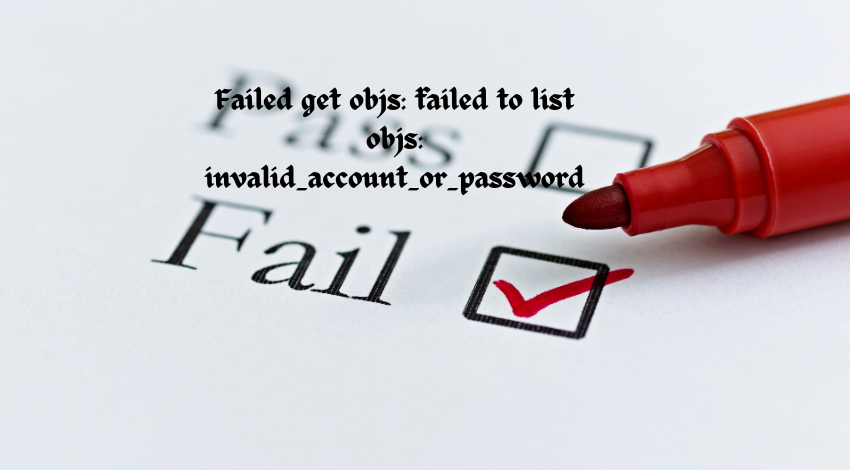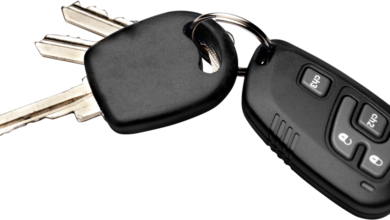“Failed get objs: failed to list objs: invalid_account_or_password”

Have you ever encountered the error message “failed get objs: failed to list objs: invalid_account_or_password” and wondered what it means? This cryptic error can be a major roadblock, especially if you’re trying to access important data or systems. Let’s dive into what this error means and how you can resolve it.
What Does “failed get objs: failed to list objs: invalid_account_or_password” Mean?
This error message typically indicates that there is a problem with your account credentials or the system’s ability to authenticate your account. It’s a common issue in environments where secure access to data or services is required, such as cloud storage systems, databases, or proprietary software platforms.
Possible Causes
Understanding the root cause is crucial to resolving this error. Here are some common causes:
Incorrect Account Credentials
- Mistyped Username or Password: Simple typos can lead to authentication failures.
- Expired Password: Many systems require periodic password changes.
Network Issues
- Connectivity Problems: Network disruptions can prevent proper communication with authentication servers.
- DNS Issues: Incorrect DNS settings can lead to failed connections.

Software Bugs
- Glitches and Bugs: Software errors can sometimes cause this issue.
- Compatibility Issues: Incompatibilities between software versions can lead to authentication problems.
Configuration Problems
- Misconfigured Settings: Incorrect settings in configuration files can prevent proper authentication.
- Outdated Configurations: Old configurations that haven’t been updated to match new system requirements.
Impact of the Error
This error can have several impacts:
On User Experience
- Frustration: Users unable to access their accounts may become frustrated.
- Productivity Loss: Time spent troubleshooting this error can lead to reduced productivity.
On System Functionality
- Service Interruptions: Critical services may be disrupted until the error is resolved.
- Data Access Issues: Inability to access important data can hinder operations.
On Data Security
- Unauthorized Access Attempts: Frequent authentication errors may indicate potential security breaches.
- Account Lockouts: Repeated failed attempts may trigger security measures like account lockouts.
Diagnosing the Issue
To resolve this error, you’ll need to diagnose the root cause. Here’s how:
Verifying Account Credentials
- Check Username and Password: Ensure you’re using the correct credentials.
- Reset Password: If unsure, reset your password.
Checking Network Connections
- Test Connectivity: Ensure your internet connection is stable.
- Resolve DNS Issues: Verify your DNS settings are correct.
Reviewing System Logs
- Error Logs: Check system logs for detailed error messages.
- Authentication Logs: Review logs related to authentication attempts.
Using Diagnostic Tools
- Network Diagnostic Tools: Tools like ping and traceroute can help diagnose network issues.
- Software Tools: Use software-specific diagnostic tools for more insights.
Step-by-Step Troubleshooting Guide
Step 1: Verify Credentials
- Check and Reset Your Password
- Visit the login page and use the “Forgot Password” feature if available.
- Ensure you follow password policies, such as using a mix of characters.
- Ensure Account Details Are Correct
- Double-check your username and password.
- Ensure you’re not using old or expired credentials.
Step 2: Network Troubleshooting
- Test Internet Connection
- Use tools like speedtest.net to check your connection.
- Restart your router if necessary.
- Resolve DNS Issues
- Use Google’s Public DNS (8.8.8.8) or another reliable DNS server.
- Flush your DNS cache using
ipconfig /flushdnson Windows orsudo dscacheutil -flushcacheon macOS.
Step 3: Software and System Checks
- Update Software
- Ensure all software is up-to-date.
- Check for updates in the software’s settings or website.
- Reinstall Applications
- Uninstall and reinstall the problematic application.
- Ensure you’re using the latest version.
Step 4: Configuration Verification
- Check Configuration Files
- Locate and review configuration files for errors.
- Use documentation to verify correct settings.
- Correct Misconfigurations
- Update any incorrect settings.
- Restart services or applications after making changes.
Advanced Troubleshooting
For more complex issues, advanced troubleshooting may be necessary:
Using Command-Line Tools
- Command-line Tools: Use tools like
curlorwgetto test network connections. - SSH and Telnet: Test remote server access using SSH or Telnet.
Analyzing Detailed Error Logs
- System Logs: Use
tail -fto monitor real-time log updates. - Application Logs: Review specific application logs for detailed errors.
Contacting Support with Detailed Reports
- Gather Information: Collect error logs and screenshots.
- Contact Support: Provide detailed information to support for faster resolution.
Preventive Measures
To prevent this error in the future, consider these measures:
Regularly Updating Passwords
- Strong Passwords: Use complex passwords and change them regularly.
- Password Management Tools: Use tools like LastPass or 1Password for secure storage.
Keeping Software Up-to-Date
- Automatic Updates: Enable automatic updates where possible.
- Regular Checks: Periodically check for updates manually.
Regular System Audits
- Security Audits: Perform regular security audits.
- Configuration Reviews: Regularly review and update configurations.

Case Studies
Real-world examples can provide valuable insights:
Example 1: Cloud Storage Access Issue
- Problem: A user couldn’t access their cloud storage.
- Solution: Resetting the password and updating the software resolved the issue.
Example 2: Database Connection Failure
- Problem: A database connection failed due to misconfigured settings.
- Solution: Correcting the configuration file and restarting the database server fixed the problem.
Common Mistakes to Avoid
Avoid these common mistakes when dealing with this error:
Ignoring Network Issues
- Assumption: Assuming it’s always a credential issue can delay resolution.
- Solution: Always check network connectivity early in the troubleshooting process.
Using Outdated Software
- Assumption: Older versions might not have necessary fixes.
- Solution: Keep all software up-to-date to prevent bugs and compatibility issues.
Overlooking Configuration Settings
- Assumption: Assuming configurations are always correct.
- Solution: Regularly review and update configuration settings.
Best Practices
Implement these best practices to minimize errors:
Implementing Robust Security Measures
- Multi-Factor Authentication: Use MFA for added security.
- Regular Security Training: Educate users about security best practices.
Regularly Backing Up Data
- Automated Backups: Set up automated backups.
- Backup Verification: Regularly verify that backups are working.
Educating Users About Security
- Training Sessions: Conduct regular security training sessions.
- Security Policies: Develop and enforce comprehensive security policies.
Tools and Resources
Here are some tools and resources to help you:
Recommended Diagnostic Tools
- Ping and Traceroute: Basic network diagnostic tools.
- Wireshark: Network protocol analyzer.
- Splunk: Log analysis tool.
Useful Online Resources and Forums
- Stack Overflow: Great for troubleshooting specific issues.
- Reddit: Helpful communities for various technologies.
- Official Documentation: Always refer to the official documentation for your software.
When to Seek Professional Help
Sometimes, professional help is necessary:
Recognizing When You Need Expert Assistance
- Persistent Issues: If the error persists despite troubleshooting.
- Complex Systems: When dealing with complex systems requiring specialized knowledge.
How to Choose the Right Professional Support
- Reputation: Choose providers with a good reputation.
- Experience: Ensure they have experience with your specific issues.
Conclusion
In conclusion, the “failed get objs: failed to list objs: invalid_account_or_password” error can be frustrating, but with the right approach, it can be resolved. By understanding the possible causes, diagnosing the issue accurately, and following a structured troubleshooting guide, you can effectively address this error and prevent it from recurring. Remember to implement preventive measures and best practices to maintain a secure and efficient system.
FAQs
What should I do if I encounter this error?
First, verify your account credentials and ensure your internet connection is stable. Follow the step-by-step troubleshooting guide provided in this article.
How can I prevent this error in the future?
Regularly update your passwords, keep your software up-to-date, and perform regular system audits to prevent this error from occurring.
Are there any tools that can help me diagnose this error?
Yes, tools like ping, traceroute, Wireshark, and Splunk can help diagnose network and system issues related to this error.
What are the most common causes of this error?
The most common causes include incorrect account credentials, network issues, software bugs, and configuration problems.
When should I contact professional support?
If the error persists despite troubleshooting, or if you’re dealing with complex systems requiring specialized knowledge, it’s best to contact professional support.



